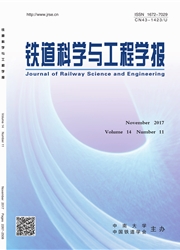

 中文摘要:
中文摘要:
为研究不同养护条件对低水胶比混凝土抗氯离子渗透性和孔结构的影响规律及程度,采用气孔分析法、压汞法和RCM法、电通量法对不同养护条件下低水胶比混凝土28 d孔结构和抗氯离子渗透性进行测试。试验结果表明:负温(-3℃)和低温(3℃)养护条件下,低水胶比混凝土比其标准养护条件下孔径明显粗化,大孔数量增多,小孔数量减少,气孔间距系数和气孔平均直径增大;低水胶比混凝土中多害孔和有害孔数量、临界孔径和最可几孔径明显比其标准养护条件下大,且负温养护条件下增大程度更大;低水胶比混凝土28 d电通量和氯离子迁移系数明显大于其标准养护条件下的混凝土,抗氯离子渗透性能明显降低;负温养护条件下,混凝土抗氯离子渗透性能下降程度很大,主要是由于负温不仅使孔的连通性增强、孔径粗化和劣化,而且对混凝土内部孔结构造成了一定程度的不可恢复的损伤。
 英文摘要:
英文摘要:
In order to study the influencing mechanism of various curing conditions on the resistance to chloride i-ons penetration and pore structure of concrete with low water-binder ratio,porosity analysis,mercury injection method,Electric flux method and RCMmethod were adopted in the study.These methods were used in the experi-ment to test the pore structure and the resistance to chloride ions penetration of the low water-binder ratio concrete after curing 28d.The result shows that the aperture of concrete with low water-binder ratio after being cured un-der minus temperature (-3℃)and low temperature (3℃)is obviously roughened than is cured under standard conditions.The number of larger aperture increases,while the number of smaller apertures decreases.The bubbles spacing factor and average pore size increase.The number of more harmful holes,the critical aperture and maxi-mum probability aperture in concrete with low water-binder ratio is evidently larger than the concrete cured under standard conditions,of which the difference is even more obvious under minus temperature.The electric flux and chloride ion migration coefficient of concrete with low water-binder ratio cured 28d are apparently larger than con-crete cured under standard conditions with the resistance to chloride ions penetration significantly reduced.The de-scending degree of resistance to chloride ions penetration is large under minus curing condition,mainly because the minus temperature not only enhances the connectivity of the pores,roughens the pores and degrades the pores,but also creates irreversible damage to concrete inner pore structure to a certain extent.
 同期刊论文项目
同期刊论文项目
 同项目期刊论文
同项目期刊论文
 期刊信息
期刊信息
